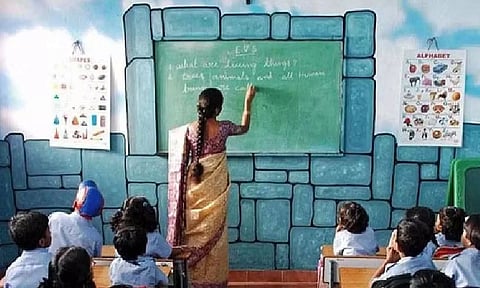

NEW DELHI: The Annual Status of Education Report (ASER) 2023 ‘Beyond Basics’ has shed some light on the current status of foundational skills for youth in the age group of 14-18. About 25% of students still could not read a Class 2 level text fluently in their regional language. More than 50% of this demographic struggles with division (3-digit by 1-digit) problems. Just 43.3% of 14-18-year-olds are able to do such problems correctly. Such skills are usually set in by the time the students hit Class 3 or 4.
Other metrics reveal that a little over half the students can read sentences in English (57.3%). And among those who can read sentences in English, almost three quarters could tell their meanings (73.5%). Across enrollment categories, girls (76%) did better than boys (70.9%) in reading a Class 2 level text in their regional language. In contrast, boys did better than their girls in arithmetic and English reading. Conducted in 28 districts across 26 states, the study reached a total of 34,745 youth in the age group 14-18 years.
In Tamil Nadu, Perambalur district was the base for assessment. Here, 97.2% of teens between 14-18 were enrolled in some form of formal educational institution (of which 70% belonged to government-run institutions). Despite the high enrolment ratio, 21.4% of those surveyed were unable to read a Class 2 level text. This is lower than the all-district average of 25%, but it is by no means a consolation. Another point of concern is 2.8% of the youth were not enrolled in any educational institute, and this was in higher prevalence among 17-18 year olds as compared to the 14-16 age group.
The figures are telling, as a report released one year ago by Tamil Nadu’s School Education Department, said over 1.3 lakh children had dropped out of school. The dropout rates were high in Salem, Tiruvallur, Tiruvannamalai, Krishnagiri as well as Kanniyakumari. Officials had remarked that most dropouts had discontinued education after Class 10 on account of reasons such as lack of interest in schools, health-related issues, lack of guidance, child marriages, child labour, and failing Class 10. Prior to that, between May 2022 and Feb 2023, it was reported that 18,426 Class 12 students, including 16,609 boys had dropped out of state board schools in Tamil Nadu, with many of them being unable to cope post the pandemic.
Obviously, there are pain points hindering the continuity of education among underserved students in Tamil Nadu. The delivery mechanism needs to be spruced up significantly. The state’s much-touted Kalvi TV initiative also needs a shot in the arm, aided by infrastructure and technology upgrades. Although run by the state government, it falls under the Centre’s Samagra Shiksha, aimed at ensuring school education from pre-primary to class 12, and providing equal opportunities for schooling and equitable learning outcomes.
Last week, the Centre government directed schools, higher education institutions, and regulators like UGC, AICTE, NCERT, NIOS, and heads of INIs like IITs, CUs and NITs to provide study material in Indian languages digitally for all courses in the next three years. It goes without saying that we must equip our youth adequately with essential knowledge, skills, and opportunities that they need to drive their own progress and that of their families and communities. Only then can India truly achieve its aspirational demographic and digital dividend.